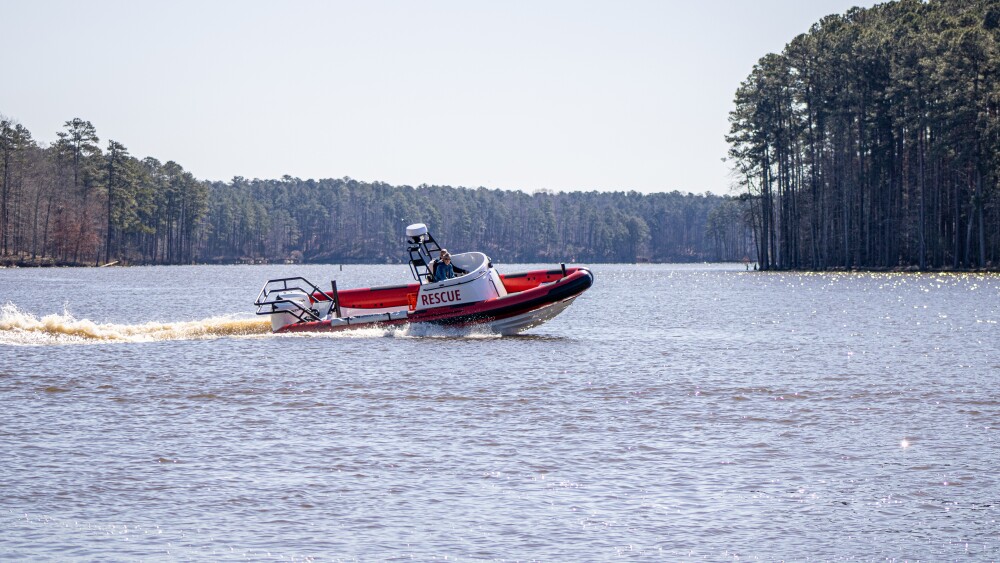When fire departments determine they need a new search and rescue (SAR) boat, they need it now, not months down the road. They also need their new boat to be rugged, durable and capable of staying afloat in all kinds of extreme weather conditions.
Fluid Watercraft’s new line of SAR boats meets these requirements, and more, while providing exceptional value for fire departments. Based in Franklinton, North Carolina, Fluid Watercraft specializes in building rigid inflatable boats (RIBs), purpose-built for demanding public safety missions, including search and rescue.
By combining a rigid hull with watertight, military-grade inflatable tubes, RIBs are buoyant, rugged and resistant to capsizing even in choppy seas. And thanks to its policy of building and stocking a standardized range of customizable RIBs, Fluid Watercraft can provide them to fire, EMS and police departments within weeks or even days of being ordered – rather than the months or years associated with bespoke ‘built-from-the-keel-up’ boats sold by its competitors.
BUILT TO BE TOUGH
Water-based search and rescues often take place in the worst of weather conditions, with hidden underwater dangers and high waves and winds that put SAR boats at risk. This is why first responders choose RIBs over conventionally hulled boats for SAR missions. Thanks to their inflated tubes, RIBs are stable and nearly unsinkable even when swamped.
Fluid Watercraft’s RIBs start with these tough advantages, then reinforce them using vacuum-infused, fiber-reinforced composite laminate hulls, military-grade removable ORCA Hypalon tubes and EPA/ABYC/USCG-compliant components and structures. This results in RIBs meeting or exceeding the demands of fire departments at affordable prices – thanks to the company’s use of a standardized design and equipment process.
This standardized approach offers plenty of useful innovations, such as Fluid Watercraft’s unique forward-pushed control console that allows for more deck space for recovery victims and medical treatment. Fluid Watercraft’s search and rescue vessels have been designed to specifically meet the needs of fire departments rather than using a more traditional type of boat layout. This allows first responders to immediately begin medical treatment while heading back to shore.
FROM SMALL TO LARGE
For SAR boat work, there are three options available to first responders. These are the company’s Swift Water Rescue 13, Search and Rescue 23 and Search and Rescue 26.
Featuring the first of its kind aluminum hull, the 13-foot Swift Water Rescue 13 (SWR 13) RIB offers optimal performance and portability to first responders facing challenging rescue scenarios. Fluid Watercraft designed the SWR 13 to maximize RIB longevity as well as operational and crew safety during swift water rescue operations.
Standard features on the SWR 13 include righting lines, high-flow scuppers, 10mm EVA decking and an aluminum hull that won’t get damaged when stored or used in water with tree branches, rocks or other debris. Options on the SWR 13 include a 5-gallon flexible fuel tank and a 30-horsepower Tohatsu Rescue Pro Engine with an enclosed rotor that protects people and the engine from accidental impacts with the propeller. Weighing in at only 181 pounds and with nine carry handles, the SWR 13 can be easily carried over ground.
Fluid Watercraft’s Search and Rescue 23 (SAR 23) RIB has an overall length of 23 feet and 7 ½ inches with enough passenger and crew capacity for 10 people. The SAR 23’s forward-pushed control console maximizes aft deck space in support of recovery operations and onboard treatment. It is powered by twin Mercury 150-horsepower engines and meets the demanding requirements of SAR missions in all weather conditions.
The larger Search and Rescue 26 (SAR 26) has a length of 25 feet and 7 inches and accommodates up to 16 people. Similarly equipped with twin 150-horsepower engines and a forward-pushed control console, the SAR 26 also maximizes its aft deck space for victim recovery and medical treatment. Outfitted with a 2 inch aluminum keel guard, this is a rugged, fast boat that can answer a range of distress calls.
MAKING ACQUISITION EASY
Waiting for manufacturers to deliver SAR boats is one of two typical delays in the acquisition process. Fluid Watercraft has addressed this first delay through its standardization policy with RIBs in stock for its customers instead of a build-to-order approach.
The second delay is caused by paperwork; filling out the right forms to obtain money either through the department’s procurement process, third-party funding such as grants, or both.
Fortunately, Fluid Watercraft has found a way to simplify the paperwork associated with buying boats from their company. Fluid’s standard boats are available via the General Services Administration GSA Advantage section of the federal government’s 1122 Program. This registration makes it fast and easy for local and state governments to purchase these search and rescue vessels.
When it comes to ruggedness, performance, availability, paperwork and price, Fluid Watercraft’s line of SAR RIBs are the capable, no-compromise solutions that fire departments demand. To find out more about how the SWR 13, SAR 23 and SAR 26 can meet your department’s needs, visit fluidboats.com.




